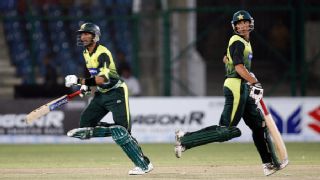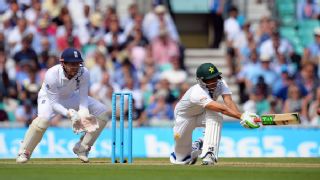|
During your career, which bowlers have you feared facing?
All of them (laughs). On a serious note, in international cricket, when you play against a top-ranked team, the pressure is not as much. However, when you play against a low-ranked team, there is more pressure since you don't want to get out to someone from a low-ranked team, with all due respect. Who have you enjoyed batting with the most out of Inzamam-ul-Haq, Mohammad Yousuf and Misbah-ul-Haq?
Whenever I batted with Mohammad Yousuf and had big partnerships with him, all of the time spent at the crease was amazing. We had good eye-contact. Shoaib Malik was another with whom I have had a great time when it comes to partnerships, since he was an athlete and was great between the wickets. I had good communication with Mohammad Yousuf and Shoaib Malik. Any tips on the sweep shot?
There are no tips. You have to be brave. If you get out sweeping, the whole world will be after you. I myself got out sweeping in my last innings, that too off a full toss. I hit my 10,000th run with a sweep. I reached my only triple hundred via a reverse-sweep. You were known as arguably one of the finest players of spin. During your triple century, you became the first man to hit Muralitharan for 100 runs in an innings. You played many sweeps in that innings - was your strategy to upset the bowler's line and length?
Yes, a spinner does get upset when he gets swept. It was always easier for me to sweep on a turning wicket since the ball would already have some break and force for me to help it on its way. Coming back to that innings, the pitch was a true batting track which helped. The Sri Lankans had piled up a lot of runs and there was nothing much for the spinners. It was a good track for sweeps. The Karachi outfield was very fast too, so any gap and it was a boundary. We had a young team, while they were playing Mendis and Murali. Do you think it is easier to sweep a legspinner or an offspinner?
I think it is easier to sweep a left-arm spinner or a legspinner since there are better chances of survival. As the ball breaks away from the right-hander, it meets the bat nicely as opposed to an offspinner turning it into you, since there are more chances of you missing the ball coming into you and it can skid through under the bat and hit you on the pads or hit the stumps. Why does a spinner get upset when they keep getting swept?
A bowler should be happy if they are constantly being swept as this is a cross-bat, risky shot. My advice to bowlers would be to not be afraid, regardless of how well one is sweeping. To give you an example: when Inzamam-ul-Haq fell on the stumps against Monty [Panesar] in England, he went to the hospital and I took charge of the team in his absence. Kevin Pietersen was in great nick at the time; he had scored a century in the first innings. As KP walked in, Danish [Kaneria] asked me for a deep square-leg protecting the boundary. I refused and encouraged him to bowl. KP swept him a few times and hit him for a few boundaries. Danish was puzzled and kept asking me for protection. I refused every time as I wanted to draw KP into my game. In Danish's second over against KP, after he had been hit for a boundary, I told him to bowl a googly. He did and it went through KP's defences and hit the stumps. Danish always took my suggestions and implemented them very well. We had a great connection.  Where should a bowler bowl when he is being swept?
Very important question. I share this with my coaches, captains and bowlers: whenever you are swept or a batsman plays cross-batted shots against you, stick to bowling stump-to-stump. You have to vary the length and pace, but bowl on the stumps. I was watching the World Cup semi-final between New Zealand and South Africa. Elliot was batting against Steyn. Elliot made room for himself and Steyn bowled wider allowing him to free his arms. He did that twice and, instead of following him, Steyn did the opposite. Against Maxwell, you have to do the same. You have to follow these kinds of batsmen when they make room for themselves. They are looking to free their arms, so don't fall into the trap of giving them that opportunity. AB de Villiers has said that he learned to sweep from you. Is that true?
No, he has not learned it from me. However, as professionals, we observe each other's games. He might have picked up some technical aspect of my sweep and implemented it in his own game. There are things that I have also picked up from AB. Do you have any tips on how to perfect a certain shot in one's game?
Take the example of Damien Martyn. What Damien Martyn used to do was use both of his feet. For example, if he was playing a front foot drive, he would also use his back foot sometimes to play the shot, since you never know if the ball will skid through. The same bowler can bowl with different pace and variation so, if you commit to the front foot and are deceived by the pace, then you can easily adjust via your back foot. The pull shot is another example of using both your feet. Many batsmen pull the ball off the back foot, while some prefer pulling off the front foot like Ricky Ponting. I have used both feet while pulling. How important is the grip?
It's very important and makes a big difference. I was always a top-hand-dominant player as the street where I grew up playing cricket was narrow. The best way to score runs there was to play in the "V". In the first Test against South Africa in Karachi [in 2007], I was bowled by Andre Nel in the first innings as a short ball stayed low and went through the gate. In the second innings, I did nothing but hold the bat lightly with my top hand and firmly with my bottom hand, which helped me hit the straight stump-to-stump balls on the on side; I managed to score a century. In the next Test, in Lahore, I was again bowled by Andre Nel by a ball which came in and beat me through the gate but then, like the first Test, I scored a century in the second innings. I am not a firm believer in changing things too much, but it is very important to have a balance and understanding of the bounce in the pitch and the sort of bowlers you will be facing. Speaking of the grip, why do you hold your bat so high in the handle?
I used to copy Abdul Razzaq and Adam Gilchrist. I believe that the bat is like a stick, so it gives you more leverage and reach especially when hitting sixes. Another comparison of this technique would be with the fishing rod, since holding it further away from you gives you more leverage and swing. Did you have different grips for fast bowlers and spinners?
Yes, I used to change the grip sometimes. For spinners, some bowlers are quicker through the air while the others are slow, so I used to hold the bat up and down the handle depending on the bowler. You must have seen me struggle in the first few innings of series, and then I would remember the bowlers and practise various scenarios, which would result in runs later on in the series. Someone like Bishoo bowls slowly through the air compared to Chase, so the grip used to change automatically.  You never missed out on a loose ball, how did you find gaps?
You can practise for gaps; whenever I batted in the nets, in my mind I imagined a certain field for that particular bowler. I would try and target hitting the gaps between those imaginary fielders. When you are in form, you find the gaps naturally. Also, the longer you spend at the crease, the easier it becomes and you find form. If you look at my double-century at The Oval, I scored my first 50 runs off 90 balls [86 balls], and the next 50 came off 40 balls [53 balls] - so you automatically find gaps after coming into form. You haven't been stumped a lot despite charging down the track often. What is the secret?
I don't believe in going out to hit. I believe that I can generate enough force staying in the crease rather than charging down the track. Normally it is a perception that to generate force, we must dance down the crease and go big which isn't correct. I only used to leave my crease when I was very settled. Sometimes in the 90s I would charge down the track to clear the in-field since at that point all the field is up creating pressure on the batsman. Tell us more about the Azharuddin advice during the England series in 2016.
It was a simple technical change which was very logical, hence I implemented it in my game. There are two ways to counter swing; you either stand outside your crease to kill as much angle of the swing as possible or you stand deep in your crease to give yourself more time. I was already doing the former but it wasn't working out for me. Azharuddin advised the latter, which made sense. I didn't change anything but going deep inside my crease. The jump that everyone made a fuss about was the same, but I had more time to play the ball since I was deep in the crease. It worked for me that day, fortunately. Batting aside, Pakistan will dearly miss you in the field, especially in the slip cordon. Any special tips for slip catching?
I used to do a few drills early on in my career to improve this area of my game. I used to feed Rashid Latif a lot during his keeping drills and that is where I started picking up some techniques such as how the keeper takes it with soft hands. After that, when Bob Woolmer joined us as a coach, I once dropped a catch standing too close. Bob worked with me on this by going through many drills and different ways of catching the ball. Doing all these drills has ruined my fingers as you can see, but hopefully they will go back to normal during my retirement years. While fielding at slips, do you watch the ball from the bowler's hand or from the bat?
Slip fielding requires a lot of concentration so I would try to watch the ball from the bowler's hand in his run-up, followed by the pitch of the ball and the batsman playing it.
|
